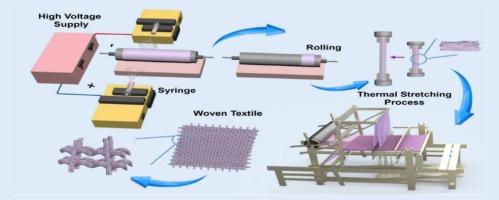Constructing Chitosan/Poly(L-lactide-co-ε-caprolactone) nanofiber yarns with highly aligned structure for biomedical applications
IF 6.3
2区 化学
Q1 POLYMER SCIENCE
引用次数: 0
Abstract
The development of advanced electrospun nanofiber yarns (ENYs) featuring highly aligned structures has garnered considerable attention, as these ENYs serve as fundamental building blocks for biomedical textile fabrication. In this work, we successfully fabricated highly aligned chitosan (CS)/poly(L-lactide-co-ε-caprolactone) (PLCL) ENYs through an innovative combination of electrospinning and thermal stretching techniques. Four CS/PLCL compositions were subjected to thermal stretching at 60 °C to generate 4 times stretching range, resulting in markedly improved fiber alignment and morphological characteristics. Mechanical characterization revealed an interesting trade-off: while Young’s modulus decreased post-stretching, elongation at break increased substantially, indicating enhanced material flexibility. Degradation studies demonstrated composition-dependent behavior, with higher CS content accelerating biodegradation rates. Notably, surface wettability was effectively tuned, as evidenced by water contact angle measurements decreasing dramatically from 130° to 69° with increasing CS content. Most importantly, the 1 % CS/PLCL formulation emerged as particularly promising, demonstrating exceptional antibacterial performance (86.2 % inhibition against E. coli) coupled with outstanding human dermal fibroblast adhesion and proliferation. Comprehensive evaluation revealed that these highly aligned nanofibers, especially the 1 % CS/PLCL variant, achieved an optimal combination of structural properties (morphology and crystallinity), degradation kinetics, antibacterial efficacy, and biocompatibility.

构建具有高度排列结构的医用壳聚糖/聚l -乳酸-co-ε-己内酯纳米纤维纱线
具有高度排列结构的先进电纺纳米纤维纱线(ENYs)的发展引起了相当大的关注,因为这些ENYs是生物医学纺织品制造的基本组成部分。在这项工作中,我们通过静电纺丝和热拉伸技术的创新结合,成功地制备了高度排列的壳聚糖(CS)/聚l -乳酸-co-ε-己内酯(PLCL) ENYs。4种CS/PLCL组合物在60℃下进行热拉伸,拉伸范围达到4倍,纤维取向和形态特征明显改善。力学特性揭示了一个有趣的权衡:拉伸后杨氏模量下降,断裂伸长率大幅增加,表明材料柔韧性增强。降解研究显示了组分依赖行为,较高的CS含量加速了生物降解速率。值得注意的是,随着CS含量的增加,水接触角从130°急剧下降到69°,从而有效地调节了表面润湿性。最重要的是,1% CS/PLCL配方显示出特别有前景,表现出卓越的抗菌性能(对大肠杆菌抑制86.2%),以及出色的人真皮成纤维细胞粘附和增殖。综合评价表明,这些高度排列的纳米纤维,特别是1% CS/PLCL变异,实现了结构特性(形态和结晶度)、降解动力学、抗菌效果和生物相容性的最佳组合。
本文章由计算机程序翻译,如有差异,请以英文原文为准。
求助全文
约1分钟内获得全文
求助全文
来源期刊

European Polymer Journal
化学-高分子科学
CiteScore
9.90
自引率
10.00%
发文量
691
审稿时长
23 days
期刊介绍:
European Polymer Journal is dedicated to publishing work on fundamental and applied polymer chemistry and macromolecular materials. The journal covers all aspects of polymer synthesis, including polymerization mechanisms and chemical functional transformations, with a focus on novel polymers and the relationships between molecular structure and polymer properties. In addition, we welcome submissions on bio-based or renewable polymers, stimuli-responsive systems and polymer bio-hybrids. European Polymer Journal also publishes research on the biomedical application of polymers, including drug delivery and regenerative medicine. The main scope is covered but not limited to the following core research areas:
Polymer synthesis and functionalization
• Novel synthetic routes for polymerization, functional modification, controlled/living polymerization and precision polymers.
Stimuli-responsive polymers
• Including shape memory and self-healing polymers.
Supramolecular polymers and self-assembly
• Molecular recognition and higher order polymer structures.
Renewable and sustainable polymers
• Bio-based, biodegradable and anti-microbial polymers and polymeric bio-nanocomposites.
Polymers at interfaces and surfaces
• Chemistry and engineering of surfaces with biological relevance, including patterning, antifouling polymers and polymers for membrane applications.
Biomedical applications and nanomedicine
• Polymers for regenerative medicine, drug delivery molecular release and gene therapy
The scope of European Polymer Journal no longer includes Polymer Physics.
 求助内容:
求助内容: 应助结果提醒方式:
应助结果提醒方式:


